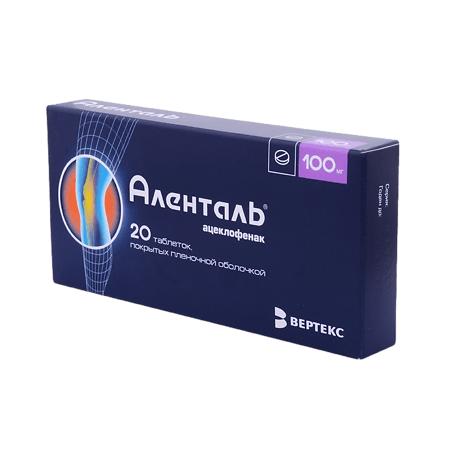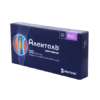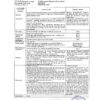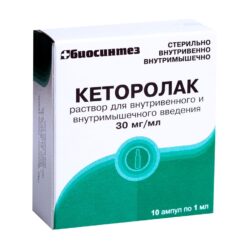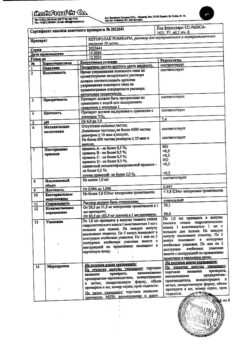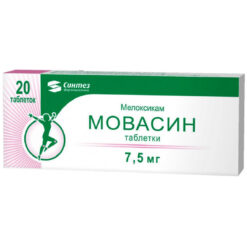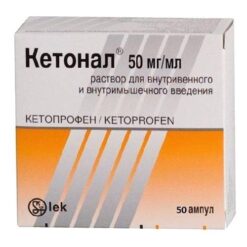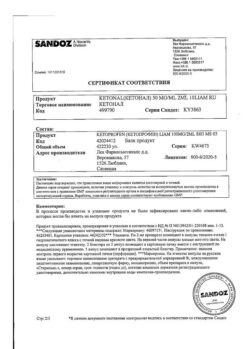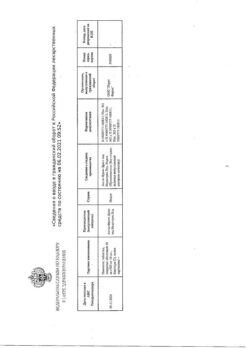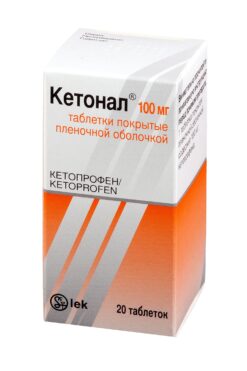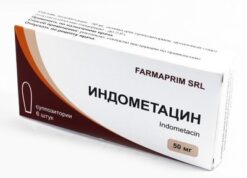No products in the cart.
Alenthal, 100 mg 20 pcs.
€11.72 €10.26
Description
Pharmacotherapeutic group
Non-steroidal anti-inflammatory drug (NSAID).
ATC code
M01AB16
Pharmacological properties
Pharmacodynamics
Aceclofenac has anti-inflammatory, analgesic and antipyretic effects. It inhibits the synthesis of prostaglandins and thus affects the pathogenesis of inflammation, pain and fever. Anti-inflammatory and analgesic effect of acheclofenac in rheumatic diseases significantly reduces the severity of pain, morning stiffness, joint swelling which improves the functional state of the patient.
Pharmacokinetics
Absorption
After oral administration aceclofenac is rapidly absorbed, its bioavailability is close to 100%. Maximum concentration (Cmax) in blood plasma is reached 1.25-3 hours after oral administration. Food intake slows absorption, but does not affect its degree.
Distribution
Aceclofenac is highly bound to plasma proteins (> 99.7%). Aceclofenac penetrates into the synovial fluid, where its concentration reaches 60% of its concentration in blood plasma. The volume of distribution is 30 liters.
Metabolism
It is believed that aceclofenac is metabolized by CYP2C9 isoenzyme to form the metabolite 4-ON-aceclofenac, whose contribution to the clinical effects of the drug is likely to be minimal. Diclofenac and 4-ONE-acetylophenac are among the numerous metabolites of acetylophenac.
Elimination
The average elimination half-life (T1/2) is 4-4.3 hours. Clearance is 5 L/hour. Approximately 2/3 of the dose taken is excreted by the kidneys, mainly as conjugated hydroxymetabolites. Only 1% of the dose after oral administration is excreted unchanged.
Indications
Indications
Relief of inflammation and pain in lumbago, toothache, glenohumeral periarthritis, rheumatic lesions of soft tissues. Symptomatic treatment of rheumatoid arthritis, osteoarthritis, ankylosing spondylitis.
The drug is intended for symptomatic therapy, reducing pain and inflammation at the time of use, and does not affect the progression of the disease.
Dysmenorrhea.
Pharmacological effect
Pharmacological effect
Pharmacotherapeutic group
Non-steroidal anti-inflammatory drug (NSAID).
ATX code
М01АВ16
Pharmacological properties
Pharmacodynamics
Aceclofenac has anti-inflammatory, analgesic and antipyretic effects. Inhibits the synthesis of prostaglandins and, thus, affects the pathogenesis of inflammation, pain and fever. In rheumatic diseases, the anti-inflammatory and analgesic effect of aceclofenac helps to significantly reduce the severity of pain, morning stiffness, and swelling of the joints, which improves the patient’s functional condition.
Pharmacokinetics
Suction
After oral administration, aceclofenac is rapidly absorbed, its bioavailability is close to 100%. The maximum concentration (Cmax) in blood plasma is achieved 1.25-3 hours after oral administration. Eating slows down absorption, but does not affect its degree.
Distribution
Aceclofenac is highly bound to plasma proteins (> 99.7%). Aceclofenac penetrates into the synovial fluid, where its concentration reaches 60% of its concentration in the blood plasma. The distribution volume is 30 l.
Metabolism
It is believed that aceclofenac is metabolized by the CYP2C9 isoenzyme to form the metabolite 4-OH-aceclofenac, the contribution of which to the clinical effect of the drug is most likely minimal. Diclofenac and 4-OH-aceclofenac are among the numerous metabolites of aceclofenac.
Removal
The average half-life (T1/2) is 4-4.3 hours. Clearance is 5 l/hour. Approximately 2/3 of the dose taken is excreted by the kidneys, mainly in the form of conjugated hydroxymetabolites. Only 1% of the dose after oral administration is excreted unchanged.
Special instructions
Special instructions
The simultaneous use of Alental® and other NSAIDs, including selective cyclooxygenase-2 (COX-2) inhibitors, should be avoided.
Adverse events can be minimized by using the lowest effective dose and reducing the duration of treatment needed to control symptoms.
Effect on the gastrointestinal tract
Bleeding, ulceration or perforation of the gastrointestinal tract with a fatal outcome was observed when taking any NSAIDs during any period of treatment, as in the presence of corresponding symptoms and a history of serious gastrointestinal diseases (peptic ulcer of the stomach and duodenum, Crohn’s disease, ulcerative colitis, etc.). and without them.
The risk of bleeding, ulceration, and gastrointestinal perforation increases with increasing doses of NSAIDs in patients with a history of peptic ulcers, especially those accompanied by bleeding or perforation, and in elderly patients. Such patients should be prescribed the minimum effective dose of aceclofenac. Also, when treating these groups of patients and patients who require simultaneous use of acetylsalicylic acid in low doses or other drugs that may increase the risk of gastrointestinal complications, the need for combination therapy with protective drugs (for example, misoprostol or proton pump inhibitors) should be considered.
Patients with gastrointestinal diseases, including elderly patients, should report any unusual gastrointestinal symptoms (especially bleeding), including when initially taking Alental®. Particular caution should be exercised in patients concomitantly taking drugs that may increase the risk of bleeding or ulceration, such as systemic corticosteroids, anticoagulants (such as warfarin), selective serotonin reuptake inhibitors, or antiplatelet agents (such as acetylsalicylic acid).
If gastrointestinal bleeding or ulcers occur, treatment with Alental should be discontinued.
Effects on both the cardiovascular and central nervous systems
Patients with arterial hypertension and/or mild to moderate congestive heart failure require appropriate monitoring, since taking NSAIDs (particularly in high doses with long-term use) may not significantly increase the risk of arterial thrombosis (for example, myocardial infarction or stroke). There is no reliable data on the absence of such a risk when taking aceclofenac.
Patients with uncontrolled arterial hypertension, chronic heart failure, established coronary heart disease, atherosclerosis of peripheral arteries and/or cerebrovascular accident should be careful when taking Alental®. Also, before taking Alental® for the first time, caution should be exercised in patients with risk factors for the cardiovascular system (for example, hypertension, hyperlipidemia, diabetes mellitus, smoking).
Effect on the liver and kidneys
Taking NSAIDs can cause a dose-dependent decrease in prostaglandin formation and acute renal failure. The importance of prostaglandins for renal blood flow should be taken into account when taking Alental® in patients with impaired cardiac, renal or hepatic function, in patients receiving diuretics, in patients after surgery, as well as in elderly patients.
Caution should be exercised when prescribing Alental® to patients with mild or moderate hepatic and renal dysfunction, as well as to patients with other conditions predisposing to fluid retention in the body. In such patients, NSAIDs may cause renal dysfunction and fluid retention. Patients taking diuretics and those at increased risk of hypovolemia should also use caution when taking Alental®. It is necessary to prescribe the minimum effective dose and regular medical monitoring of renal function. Adverse renal events usually resolve after discontinuation of aceclofenac.
Aceclofenac should be discontinued if changes in liver function tests persist or worsen, clinical signs or symptoms of liver disease develop, or other manifestations (eosinophilia, rash) occur. Hepatitis can develop without prodromal symptoms.
The use of NSAIDs in patients with hepatic porphyria may precipitate an attack.
Hypersensitivity and skin reactions
Like other NSAIDs, aceclofenac can cause allergic reactions, including anaphylactic/anaphylactoid reactions, even when taken for the first time. Severe skin reactions (some of which can be fatal), including exfoliative dermatitis, Stevens-Johnson syndrome and toxic epidermal necrolysis, have been observed very rarely after taking NSAIDs. The highest risk of these reactions occurs during the first month of taking aceclofenac. If skin rash, damage to the oral mucosa or other signs of hypersensitivity occur, you should stop taking Alental®. In some cases, chickenpox can cause skin and soft tissue infections. At present, the role of NSAIDs in worsening the course of these infections cannot be ruled out. Therefore, you should avoid taking Alental® for chickenpox.
Hematological disorders
Aceclofenac may cause reversible inhibition of platelet aggregation.
Respiratory system disorders
Caution should be exercised when taking Alental® to patients with a history of bronchial asthma or current bronchial asthma, since taking NSAIDs may trigger the development of sudden bronchospasm in such patients.
Elderly patients
Caution should be exercised when taking Alental in elderly patients, as they are more likely to experience side effects (especially bleeding and gastrointestinal perforation) when taking NSAIDs. Complications can be fatal. Older patients are also more likely to suffer from kidney, liver, or cardiovascular diseases.
Long-term use
All patients receiving long-term treatment with NSAIDs should be closely monitored (eg, complete blood count, liver function tests, and renal function tests).
Impact on the ability to drive vehicles and machinery
You should refrain from driving vehicles and engaging in other potentially hazardous activities that require increased concentration and speed of psychomotor reactions, as the drug may cause dizziness and other side effects that may affect these abilities.
Active ingredient
Active ingredient
Aceclofenac
Composition
Composition
One film-coated tablet contains:
active substance: aceclofenac – 100.0 mg;
excipients: microcrystalline cellulose – 82.6 mg; croscarmellose sodium – 8.0 mg; povidone K-30 – 6.4 mg; sodium stearyl fumarate – 3.0 mg;
film coating: [hypromellose – 3.6 mg, talc – 1.2 mg, titanium dioxide – 0.66 mg, macrogol 4000 (polyethylene glycol 4000) – 0.54 mg] or [dry mixture for film coating containing hypromellose (60%), talc (20%), titanium dioxide (11%), macrogol 4000 (polyethylene glycol 4000) (9%)] – 6.0 mg.
Pregnancy
Pregnancy
Pregnancy
Alental® is contraindicated during pregnancy. There is no information on the use of aceclofenac during pregnancy. Inhibition of prostaglandin synthesis may adversely affect the course of pregnancy and/or the development of the embryo/fetus.
During the third trimester of pregnancy, all prostaglandin synthesis inhibitors, having cardiopulmonary toxicity, can cause premature closure of the ductus botellus with the development of pulmonary hypertension, as well as impaired fetal renal function, which can progress to renal failure in combination with polyhydramnios.
Women in late pregnancy and newborns: Aceclofenac may affect the duration of bleeding due to an aptiplatelet effect, which can occur even after very low doses: aceclofenac may suppress uterine contractions, leading to delayed labor or prolonged labor.
Breastfeeding
Alental® should not be taken during breastfeeding. There are no data on the excretion of aceclofenac in breast milk; When radioactive 14C-aceclofenac was administered to lactating rats, no noticeable transfer of radioactivity into milk was observed.
Fertility
NSAIDs may affect fertility and are not recommended for use by women planning pregnancy.
Contraindications
Contraindications
– erosive and ulcerative lesions of the gastrointestinal tract (GIT) in the acute phase (including ulcerative colitis, Crohn’s disease);
– gastrointestinal bleeding or suspicion of it;
– complete or incomplete combination of bronchial asthma, recurrent polyposis of the nose and paranasal sinuses and intolerance to acetylsalicylic acid or other NSAIDs (including a history);
– hypersensitivity to aceclofenac or components of the drug;
– severe liver dysfunction or active liver disease;
– disorders of hematopoiesis and coagulation;
– severe renal dysfunction (creatinine clearance <30 ml/min), progressive kidney disease, confirmed hyperkalemia;
– decompensated heart failure;
– period after coronary artery bypass grafting;
– pregnancy and breastfeeding period;
– age up to 18 years.
With caution
History of liver, kidney and gastrointestinal diseases; presence of Helicobacter pylori infection; bronchial asthma; arterial hypertension; decrease in circulating blood volume (including immediately after major surgical interventions); coronary heart disease; chronic renal, liver and heart failure; creatinine clearance less than 60 ml/min; history of ulcerative lesions of the gastrointestinal tract; cerebrovascular diseases; dyslipidemia/hyperlipidemia; diabetes mellitus; peripheral arterial disease; smoking; old age; alcoholism; severe somatic diseases; in patients with hemostasis defects, at risk of developing cardiovascular thrombosis (myocardial infarction, acute cerebrovascular accidents (ischemic, hemorrhagic stroke)); systemic lupus erythematosus; long-term use of NSAIDs; simultaneous use of glucocorticosteroids, anticoagulants, antiplatelet agents, serotonin reuptake inhibitors.
Side Effects
Side Effects
Classification of the incidence of side effects according to the recommendations of the World Health Organization (WHO):
very often > 1/10;
often from > 1/100 to < 1/10;
infrequently from > 1/1000 to < 1/100;
rarely from > 1/10000 to < 1/1000;
very rare <1/10000, including isolated reports.
Blood and lymphatic system disorders:
rarely – anemia;
very rarely – bone marrow suppression, granulocytopenia, thrombocytopenia, neutropenia, hemolytic anemia.
Immune system disorders:
rarely – anaphylactic reactions, including shock; hypersensitivity.
Mental disorders:
very rarely – depression, “unusual” (atypical) dreams, insomnia.
Nervous system disorders:
often – dizziness;
very rarely – paresthesia, tremor, drowsiness, headache, dysgeusia (taste perversion).
Visual disorders:
rarely – visual impairment.
Hearing and labyrinth disorders:
very rarely – vertigo, tinnitus.
Cardiovascular system disorders:
rarely – heart failure, increased blood pressure;
very rarely – tachycardia, skin hyperemia, “hot flashes” (short-term sensation of heat accompanied by increased sweating), vasculitis.
Disorders of the respiratory system, chest and mediastinal organs:
rarely – shortness of breath;
very rarely – bronchospasm.
Gastrointestinal disorders:
often – dyspepsia, abdominal pain, nausea, diarrhea;
uncommon – flatulence, gastritis, constipation, vomiting, ulceration of the oral mucosa;
rarely – melena, ulceration of the gastrointestinal mucosa, hemorrhagic diarrhea, hemorrhages of the gastrointestinal mucosa;
very rarely – stomatitis, vomiting blood, intestinal perforation, worsening of Crohn’s disease and ulcerative colitis, pancreatitis.
Disorders of the liver and biliary tract:
often – increased activity of liver enzymes;
very rarely – liver damage (including hepatitis), increased alkaline phosphatase activity;
Disorders of the skin and subcutaneous tissues:
uncommon – itching, rash, dermatitis, urticaria;
rarely – angioedema;
very rarely – purpura, eczema, severe reactions from the skin and mucous membranes (including Stevens-Johnson syndrome and toxic epidermal necrolysis);
Serious skin and soft tissue infections have been reported in isolated cases when NSAIDs were taken during chickenpox.
Renal and urinary tract disorders:
infrequently – increased concentrations of urea and creatinine in the blood plasma;
very rarely – nephrotic syndrome, renal failure, interstitial nephritis.
Common disorders:
very rarely – increased fatigue, muscle spasms of the lower extremities.
Metabolic and nutritional disorders:
very rarely – hyperkalemia, weight gain.
Interaction
Interaction
With the exception of warfarin, no drug interaction studies have been conducted.
Aceclofenac is metabolized by the CYP2C9 isoenzyme; In vitro data indicate that aceclofenac may be an inhibitor of this enzyme. Thus, the risk of pharmacokinetic interaction is possible when taking aceclofenac simultaneously with phenytoin, cimetidine, tolbutamide, phenylbutazone, amiodarone, miconazole and sulfaphenazole.
As with other NSAIDs, the risk of pharmacokinetic interaction with other drugs that are eliminated from the body by active renal secretion, such as methotrexate and lithium, increases.
Aceclofenac is highly bound to plasma albumin and, therefore, there is the possibility of displacement interactions with other protein-bound drugs.
Below is class-specific information for NSAIDs.
Methotrexate: NSAIDs inhibit tubular secretion of methotrexate; Moreover, a slight metabolic interaction may occur, resulting in decreased methotrexate clearance. Therefore, when using high doses of methotrexate, NSAIDs should be avoided.
Lithium and digoxin: Some NSAIDs inhibit the renal clearance of lithium and digoxin, resulting in increased plasma concentrations of both substances. Coadministration should be avoided unless plasma concentrations of lithium and digoxin are frequently monitored.
Anticoagulants: NSAIDs inhibit platelet aggregation and damage the gastrointestinal mucosa, which may lead to increased effects of anticoagulants and increase the risk of gastrointestinal bleeding while taking anticoagulants. The combined use of aceclofenac and oral coumarin anticoagulants, ticlopidine and thrombolytics should be avoided unless the patient’s condition is carefully monitored.
Antiplatelet agents and selective serotonin reuptake inhibitors (SSRIs) may increase the risk when used together with NSAIDs.
gastrointestinal bleeding.
Cyclosporine, tacrolimus: When taking NSAIDs concomitantly with cyclosporine or tacrolimus, the risk of increased nephrotoxicity due to decreased renal prostacyclin formation should be considered. Therefore, renal function should be carefully monitored during concomitant use.
Other NSAIDs: Concomitant use of acetylsalicylic acid or other NSAIDs may increase the incidence of side effects, so caution should be exercised.
Glucocorticosteroids: the risk of developing gastrointestinal ulcers or gastrointestinal bleeding increases.
Diuretics: aceclofenac, like other NSAIDs, can inhibit the activity of diuretics and may reduce the diuretic effect of furosemide and bumetanide and the antihypertensive effect of thiazides. Co-administration with potassium-sparing diuretics can lead to an increase in potassium levels in the blood plasma. Aceclofenac did not affect blood pressure control when used in combination with bendrofluazide, although interactions with other diuretics cannot be excluded.
Antihypertensive drugs: NSAIDs may also reduce the effect of antihypertensive drugs. Concomitant use of angiotensin-converting enzyme (ACE) inhibitors or angiotensin II receptor antagonists and NSAIDs may lead to impaired renal function. The risk of acute renal failure, which is usually reversible, may be increased in some patients with impaired renal function, such as the elderly, or those who are dehydrated. Therefore, caution should be exercised when using antihypertensive drugs with NSAIDs. Patients should consume the required amount of fluid and be under appropriate monitoring (monitoring of renal function at the beginning of co-administration and periodically during treatment).
Hypoglycemic agents: Clinical studies show that diclofenac can be used in conjunction with oral hypoglycemic agents without affecting their clinical effect. However, there are isolated reports of hypoglycemic and hyperglycemic effects of diclofenac. Thus, when taking aceclofenac, dosages of drugs that can cause hypoglycemia should be adjusted.
Zidovudine: The risk of hematological toxicity increases when NSAIDs are taken concomitantly with zidovudine. There is evidence of an increased risk of hemarthrosis and hematomas in HIV-positive (HIV – human immunodeficiency virus) patients with hemophilia receiving zidovudine and ibuprofen.
Mifepristone: aceclofenac can be used 8-12 days after taking mifepristone, since NSAIDs reduce the effect of drugs in this group.
Cholestyramine: Other drugs, including NSAIDs, should be taken at least 1 hour before or 4-6 hours after taking cholestyramine to reduce its effect on drug absorption.
Overdose
Overdose
There is no evidence of aceclofenac overdose in humans.
Possible symptoms:
Nausea, vomiting, pain in the stomach, dizziness, headache, hyperventilation with increased convulsive readiness.
Treatment:
Gastric lavage, administration of adsorbents (activated carbon), symptomatic therapy. Forced diuresis and hemodialysis are not effective enough.
Storage conditions
Storage conditions
Store in a place protected from light at a temperature not exceeding 25 °C.
Keep out of the reach of children.
Shelf life
Shelf life
3 years. Do not use after expiration date.
Manufacturer
Manufacturer
Vertex, Russia
Additional information
| Shelf life | 3 years. Do not use after the expiration date. |
|---|---|
| Conditions of storage | Store in a light-protected place at a temperature not exceeding 25 °С. Keep out of reach of children. |
| Manufacturer | Vertex, Russia |
| Medication form | pills |
| Brand | Vertex |
Related products
Buy Alenthal, 100 mg 20 pcs. with delivery to USA, UK, Europe and over 120 other countries.

